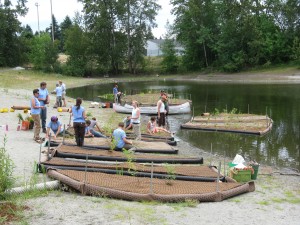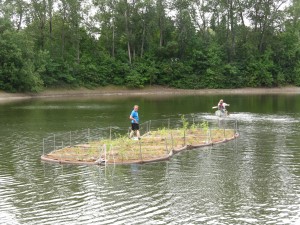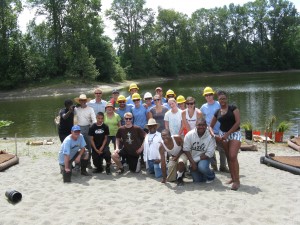by Sally Abella, King County
Hoping to address chronic water quality problems in urban Hicklin Lake south of Seattle, a team of local residents, state and county agencies, and lake experts has come together to install floating wetland treatment systems (“floating islands”) on the lake.

Floating wetland treatment systems are engineered, vegetated rafts made of natural or inert materials that mimic floating bog mats.
Floating wetland treatment systems are engineered, vegetated rafts made of natural or inert materials that mimic floating bog mats. The root systems of the island dangle into the water, taking up both nutrients and pollutants, and provide a substrate for extensive biofilms that also work to improve water quality. Some islands are passive, while others include aerators to increase water movement across the roots and biofilm. Floating islands are also used to create habitat for nesting birds and to shade water to reduce summer temperatures.
Floating islands are not a new technology, but they have not been used very often in the Pacific Northwest and so far we know of no other islands installed to improve water quality other than water temperatures in Washington State’s public lakes. However, they have been used in other areas around the world, most often in stormwater detention ponds, sewage treatment lagoons, and urban canals. Local residents and County staff trying to address ongoing nutrient problems at Hicklin Lake think it’s worth a try here.
Also known as Hicks Lake and Lake Garrett, Hicklin is a lake of about 4.2 acres in Lakewood Park in urban White Center, just south of Seattle. White Center is fully developed and hosts a mixture of residential and commercial uses, including small food services and shops, car repair and light industry. All the stormwater in the watershed flows into the lake through a repurposed combined sewer line. At least two illicit connections to the stormwater pipes have been found and fixed in recent years, but more are expected to be found.
The lake has no natural outlet, but after repeated flooding of the park by winter stormwater, pumps were installed to move water from the lake directly to Puget Sound when water levels threatened park use. The legacy of stormwater input, though — high levels of phosphorus and nitrogen that fuel nuisance blue-green blooms in summer — has essentially halted community residents’ use of the lake.

The floating islands are anchored near the middle of the lake. Each island is planted with 18 wetland shrubs and approximately 500 rushes and sedges.
Because the water level fluctuates widely through the year, Hicklin Lake’s shoreline is essentially devoid of emergent plants. Several park and community planting projects have attempted to increase vegetation, but have met with little success, due to both vandalism and the variable water levels.
Water quality has been a problem at the lake for many years, documented by data going as far back as 1996. By 2004, toxicity testing revealed that some cyanobacteria in the lake were producing microcystin, which prompted King County to finance an alum treatment in 2005 to reduce the available phosphorus fueling the algae blooms. This improved conditions markedly for about four years, but by 2010, cyanobacterial toxicity was again detected, and a second alum treatment was carried out in 2011. This time the treatment proved less successful, and a bloom developed in 2012.
Area residents drew King County’s attention to floating islands in early 2012 as an alternative to chemical treatments. The Friends of Hicklin Lake advocated using the technology in the lake, believing that the floating islands would more closely imitate natural systems to decrease nutrients and pollutants in the water.
Funding from a Washington Department of Ecology (WDOE) algae control grant and King County Surface Water Management made possible the installation of two 600 square foot passive islands in Hicklin Lake in mid-July 2013. Many people and groups contributed to the successful construction and installation of the islands. Herrera Environmental and Biomatrix Water collaborated as contractors and remained on site to direct the work of installing the islands. A team from the Washington Conservation Corps and staff from the King County Water and Land Resources Science Section provided labor and project management, while two University of Washington students interested in floating island design volunteered their labor to experience construction first-hand. King County YouthSource provided a team of summer interns as well.
The floating islands are anchored near the middle of the lake, equidistant from the routine monitoring site and well offshore to guard against possible vandalism. Each island is planted with 18 wetland shrubs and approximately 500 rushes and sedges. Fencing has been erected around the perimeter to keep the young plants from being trampled by ducks, and sparkling mylar tape strung over the top should discourage geese from dropping in for snacks.

Our team of local residents, state and county agencies, and lake experts came together to install floating wetland treatment systems (“floating islands”) on Hicklin Lake.
Monitoring for nutrients, fecal coliform bacteria and primary metal pollutants began in May 2013 and will continue for two summers to look for changes in whole lake concentrations. While there is evidence that floating islands are effective in aquatic systems with very high nutrient loads, the concentrations in Hicklin Lake are lower than the published data. It will be interesting to see if they can perform well in the range of nutrients found in the lake.
We hope these systems will be effective in our area and can be added to the tool kit of Pacific Northwest lake managers working to address water quality problems in freshwater bodies.
For more information about the floating islands project at Hicklin Lake, email sally.abella@kingcounty.gov.









